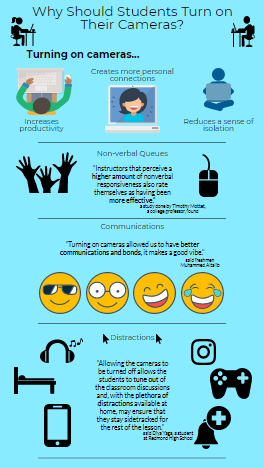Why Should Students Turn on Their Cameras?
In the non-virtual world, a student can’t choose to turn off their face, so why should they online? In most virtual classrooms, students are turning their cameras off during lessons and in breakout groups. This could be because students feel embarrassed to be the only one showing their face, or because they are not paying attention. While it is the student’s choice whether or not they turn on their cameras, showing your face increases productivity by keeping you focused, reduces a sense of isolation by creating more personal connections, and makes situations less awkward. It can be argued that forcing students to turn on their cameras is an invasion of privacy. While it is true that turning on your camera gives others a view of your surroundings, be aware of what is around you, and prepared to let others see.
Letting others see what you’re doing increases productivity. You are much more likely to pay attention and stay on task when the teacher and peers can see you in person, and it’s no different online. Turning on your camera allows others to see when you are doing, and it is likely you would want to look productive. It also causes you to get less distracted by objects or phones. “Allowing the cameras to be turned off allows the students to tune out of the classroom discussions and, with the plethora of distractions available at home, may ensure that they stay sidetracked for the rest of the lesson,” said Diya Yaga, a student at Redmond High School in her school newspaper.
Having cameras turned on reduces a sense of isolation by creating more personal connections. It is easy to feel like you’re alone in a class when all you can see are other peoples’ names. Being in a breakout group where you can see other people helps make online school feel more real and allows you to get to know each other better. Being able to connect a person’s name with their face is helpful, because it allows you to recognize them in public, or when in-person school starts again. “Turning on cameras allowed us to have better communications and bonds, it makes a good vibe,” said freshmen Muhammed Altalib.
Along with increased productivity and better connections, turning on your camera makes breakout groups less awkward. Long stretches of silence can feel weird, but if you can see other group members working, it’s not. It can also help you read body language that just turning on your microphone can’t. Lastly, nodding your head yes or shaking your head no is an easy way to reach a conclusion in a convenient, quick way that is unique to interaction with cameras turned on. A study was done researching non-verbal queues between students and teachers and found, “Instructors that perceive a higher amount of nonverbal responsiveness also rate themselves as having been more effective.”
All in all, there are many benefits of turning on your camera during class. It might feel awkward to do at first, especially if you are the only one, but usually, people just need one person to start, and they will follow.
Citations:
https://onlinelibrary.wiley.com/doi/10.1002/ece3.7123
https://www.tandfonline.com/doi/abs/10.1080/03634520009379202
https://www.idstewardship.com/turn-zoom-cameras/
https://blog.gotomeeting.com/6-reasons-turn-webcam-online-meetings/
https://www.reviewforrelief.org/posts/turning-on-cameras-in-virtual-learning-the-pros-and-cons



